
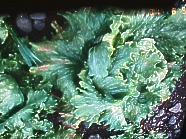
Lettuce Pests and Diseases


Impact
Downey Mildew is the most serious lettuce disease in the San Luis Valley of Colorado. It is also a serious disease in some of the cool, wet and areas where fog occurs. It can affect quality and in serious cases kill the crop off very fast.
Description and Symptoms
The fungus attacks the older leaves causing a light green to chlorotic areas with white spores in these areas on the underside of the leaves. The spores are produced on branched stalks that look like trees. The lesions are angular and tend to be confined by the veins. As the disease progresses the lessions enlarge and can turn necrotic in which case oospores may be formed. All stages of the plant are suceptible. Mildew seldom kills the plant except if infection occurs heavy on the cotyledons or early leaves. Early infections can result in systemic infection in which case the vascular tissue turns brown to dark brown.
Integrated Management
Damp and cool conditions result in downey mildew infections. There are some models now that predict downey mildew infection. They basically are based on if morning dew lasts on the leaves till after 10 a.m. sporilation will occur. Drying winds can sun can reduce disease incidence. Control is managed by: resistent varieties, aviod overhaed irrigation in the morning, using surface or sub-surface irrigation, good crop rotation, a healthy crop, and fungicides. Both systemic and protectant fungicides are available but many strains of mildew are resistent to metalaxl. If the infection is minor and maily on the lower leaves, the crop can still be harvested if infected leaves can be pealed off.
Impact
Powdery mildew is not a problem in Colorado, but it is a problem in other lettuce growing areas. Unlike downey mildew, powdery mildew is favored by warm, dry conditions. The disease can reduce quality, but it is not commonly economically important.
Description and Symptoms
Powdery mildew produces whitish sporulation like downey mildew, but it can occur on the upper as well as the lower side of leaves and powdery mildew spores are produced on chains on a single stalk. Sometimes powdery mildew spores produce small black fruiting bodies. Powdery mildew spreads in a circular pattern spreading a dusty growth over the whole leaf.
Integrated Management
Powdery mildew rarely requires control measures. Sulfur has been used in controlling this disease.
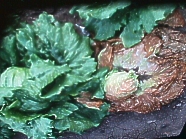
Impact
Lettuce drop is not a serious disease of lettuce in the San Luis Valley of Colorado, although it is almost always present in low levels. In other lettuce growing areas, lettuce drop is a major disease requiring regular control measures.
Description and Symptoms
Lettuce drop prefers cool moist conditions. The disease affects plants when they reach maturity and comes on suddenly casing the lettuce head to wilt and die. Under the dying plant is cottony white mycelium with hard small black sclerotia that look like mouse turds. It is caused by two fungii: S. minor which infects under drier conditions and S. sclerotiorum. Both diseases can survive in the soil as sclerotia for 2 - 3 years without a host Alternate hosts include: canola, potatoes, beans, and many weeds. The fungus infects the plant though dead tissue during conditions of free water on leaves.
Integrated Management
Any thing to reduce wet soil and lower plant canopy conditions will help reduce drop problems. Careful irrigation practices, a lower plant stand, orienting the rows to take advantage of drying winds, harvesting the field if drop shows up to open up the stand, and improving soil drainage can help in lettuce drop control. Good crop rotation and plowing can reduce primary inoculum. Good weed control can also reduce alternate host weeds.
Impact
Antracnose is rarely a problem in Colorado, but can be a problem in other cool wet areas where lettuce is grown.
Description and Symptoms
This disease is also called shothole for the appearance of the disease on the leaves. The disease starts as small, yellow, water-soaked spots on the lower leaves that darken, enlarge slightly and then dry up. After awhile the centers fall out leaving small holes in the leaves. Affected leaves wilt and die. Cool temperatures and free moisture are required for disease spread. Overhead irrigation is excellent in spreading the disease. Wild prickly lettuce is an important alternate host.
Integrated Management
Several practices can control antracnose. Control prickly lettuce weeds near your fields. Don't cultivate infected fields while wet to avoid spreading the disease manually. Good crop rotation, plowing to bury infected residuals, using surface or sub-surface irrigation, and fungicides are also effective in controlling this disease.
Impact
Bottom rot can cause serious losses in lettuce and is an occasional problem in Colorado.
Description and Symptoms
Lesions occur on the lower leaves in contact with the soil, stem and lower midribs. The lesions appear as small sunken rust to brown colored spots. If conditions are right these spots can enlarge rapidly to rot leaf midribs and leaf blades. Amber colored droplets sometimes ooze from infected midribs. The disease then can spread up the head. The entire head can rot and die from this disease, although its usually a quality problem. Secondary organisms like soft rot can enter though the rhizoctonia infection site. Rhizoctonia has a wide spectrum of alternate hosts and is favored by warm moist conditions.
Integrated Management
Control measures are limited to cultural and irrigation practices to limit overly wet soil surfaces where the disease can get started such as high lettuce beds, good drainage and careful irrigation late season. . Plowing to bury sclerotia and crop rotation have limited control potential. There are some fungicides available.
Impact
This is a serious disease in some lettuce growing areas where lettuce has been repeatedly cropped. It is at present not found in Colorado.
Description and Symptoms
The is at time no above ground symptoms in mild cases, but in severe cases wilting, yellowing and poor head development can occur. The disease caused by Rhizomonas sp. and unidentified bacteriums. Symptoms on the roots start as discrete yellow lesions that develop into greenish brown bands around the roots. Infected roots develop corky lateral ridges and are swollen and eventually the tap root rots off leaving only a stump. It does not have the redish discoloration of the root cortex as in ammonium toxicity.
Integrated Management
Its important to not spread this disease to new fields from infected fields since it is difficult to control once present. Don't move soil from infected areas and clean off equipment before using if there is any chance of infection occurring. Crop rotation is very important once infection has occurred. Improving soil drainage, high beds, breaking up compaction layers, careful irrigation to avoid excess water, rye cover crops, using transplants instead of direct seeding, and resistant cultivars are all useful in controlling this disease.

Impact
This disease can be very damaging in lettuce that has sustained another damage such as a light freeze, hail and wind damage. Normally it is a very minor disease.
Description and Symptoms
First symptoms are small water-soaked lesions that typically occur on mature leaves. As the disease progresses these lesions expand and turn necrotic resulting in large black areas and the leaf will die. The disease can spread into the head. If the diseased heads are packed in a box, secondary organisms can enter the bacterial blight lesions and cause the head to slime and rot. This disease is commonly found in most soil and may come on the seed, but seams to need an injury to enter and infect the plant such as frost, hail and wind damage. Wheat can also have similar problems.
Integrated Management
Copper based bactericides applied shortly after damage to the plant can give marginal control. If a field has a history of bacterial blight care should be taken and crop residual buried or burned.
Impact
Various viruses infect lettuce plants and can be a serious disease, but disease free and indexed seed from New Zealand has virtually eliminated this disease problem.
Description and Symptoms
Leaves with yellow to white areas and mottling are typical symptoms. Leaf rolling and plant stunting can also occur. The color variation is irregular and only on parts of the leaf as compared to the general yellowing of yellows. The disease is spread by aphids and is seedborne.
Integrated Management
Disease free and disease indexed seed from New Zealand has virtually eliminated this disease problem.
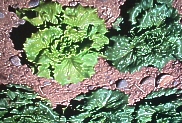
Impact
This disease is rarely a problem in lettuce fields.
Description and Symptoms
The symptoms start as a blanching and chlorosis of young leaves, the inner leaves fail to develop or are stunted. The whole plant can get a yellow crisp look. Pink to tan latex deposits develop on the undersides of the midribs. This disease is caused by a microplasmalike organism and is spread by the aster leafhoppers. This disease can be more serious in fields near weedy areas. Aster yellows affects many other crops in addition to lettuce.
Integrated Management
Control of the aster leafhopper early season is the primary control measure. Controlling weedy reservoirs near fields may also be necessary, but no control measures are often needed.
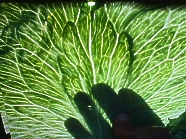
Impact
This disease often occurs in the early blocks of lettuce and can be of economic importance in Colorado as well as other lettuce growing areas.
Description and Symptoms
This disease has a very distinctive symptom of clearing of the plant tissue next to the leaf veins resulting in veins that look big when back lit by the sun. Leaves may also get pucker and ruffle. Head development in infected plants is delayed or poor. The disorder is caused by an unidentified organism vectored by a root inhabiting fungus - Oipidium brassicae. The disease is favored by cool weather. Symptoms don't occur until at least 35 days after planting. The problem can remain in the soil for many years so crop rotation is not a good control measure.
Integrated Management
Improving soil drainage is about the only control measure available. There are some tolerant varieties and no chemical control.
Tip Burn and Rib Blight
Impact
These problems can cause serious quality problems in marketing lettuce and are difficult to control since their causes are not well understood.
Description and Symptoms
Tip burn: Symptoms are not apparent on the outside of the head, but break open a head and on the inner leaves ther will be vein discoloration and brown to black spots near the leaf margins.
Rib Blight: This is also called brown rib and is characterized by brown to black discoloration of the lower midrib and vascular branches off the midrib.
Integrated Management
Tip burn is thought to be a result of calcium deficiency. Applying additional calcium does not always solve this problem and it can occur on calcium rich soils. Problems with calcium uptake by plants may be the problem. Foliar calcium applications may help as well. Warm temperatures, rapid growth, excess late fertilization are also possible sources.
Rib Blight tends to occur when periods of cool weather are followed by hot weather. Some varieties are more suceptible than others. Control measures are not known except a strong lettuce market that seams not to notice it.
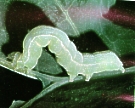

Impact
These two worms cause significant damage annually to lettuce in most growing areas. They cause problems in damaging leaves and food quality problems if worms are found in shipped lettuce. One worm found in a load can reject a load - dead or alive..
Description and Symptoms
Loopers: Loopers are greenish worms lacking the inner legs between the front legs and back prolegs requiring them to "loop" or arch their middles to move. The brown dusty adult moths lay domed-shaped eggs singly on mostly the underside of leaves. The first instar feeds mostly on the underside of the leaves and just eats the surface. Later instars may move into the plant, eat holes in the leaves and leave greenish brown feces.
Armyworms: Are worms ranging from green to black in color and have three legs in the middle of their bodies so they creep across a leaf. The brown dusty adult moth lays its eggs in bunches covered with white scales. The newly hatched worms feed in groups, skeletonizing the leaf. As the grow they move out and devastate a lettuce plant. They will feed on the crown of the lettuce plant.
Integrated Management
Monitoring is important in controlling both these pests. Monitor the plants and weeds nearby for eggs. The eggs take 5 - 10 days to hatch and the first instar of worms does very little damage. Pheromone traps can be very effective in predicting egg laying waves. Natural enemies can keep populations below problems levels. Bt and pirethiod insecticides are very effective in controlling these pests. Time insecticides after most of the eggs have hatched and worms are in first two instars. Insecticides will not kill eggs. Bt's have good residual activity. Before thinning lettuce crops can tolerate twice as much small worms. Don't let worms get much bigger than a dime or they will be difficult to control. The threshold level is very low since just a few worms in shipped lettuce can result in rejection.
Impact
This worm causes similar damage as the preceding worms, but it behavior of boring into the head makes it a much more serious pest of lettuce. Once inside the head it is very difficult to control.
Description and Symptoms
The dusty brown adult moth lays its eggs singly on the leaves which develop a red to brown ring in 24 hours. The eggs darken before hatching. Corn earworn eggs are more round and ridged than the flattened looper eggs. Corn earworms have three inner legs and do not loop when they move. The worms usually develop distinct stripes as they mature and vary in color from green to black. Corn earworms appear more hairy than loopers. Corn earworms feed mostly on the center of the plant, damaging new inner leaves. As the plant mature the corm earworms bore into the head making the head unmarketable.
Integrated Management
Once inside the head, corn earworms are very difficult to control. Monitoring is very important before this occurs. Field scouting for eggs and pheromone traps are very useful. Natural enemies kill many eggs. Before thinning lettuce crops can tolerate twice as much small worms. Do not treat a field until most of the eggs have hatched. Corn earworms must be controlled at a much earlier stage than looper since they feed on more sensitive plant parts. Keep worm levels very low once heads have formed with insecticides.
Leafhoppers

Impact
The aster leafhopper (Macrosteles quadripunctulatus) can vector aster yellows. Other leafhoppers, although not a vector, in high populations can damage leaves during feeding. Just their presence, dead or alive, in the harvested crop can cause serious quality problems. Difficulty in identifying different leafhoppers also makes control necessary at times.
Description and Symptoms
Leafhoppers are small, triangle or wedge shaped bugs that hop and fly when disturbed. Leafhoppers tend to fly in a straight path after their hop as apposed to flies which travel more randomly. Their color varies from brown to bright green. Their wings sit tent-like over their bodies as apposed to flies whose wings sit flat on their bodies. They are 2.5 - 3.5 mm or 1/8 inch long and overwinter adults or eggs. Aster leafhoppers have six black spots on top of their head. Leafhoppers are sucking insects and require 2 to 4 weeks to complete their life cycle. A low percentage of aster leafhoppers as the yellows virus and not all leafhoppers in a field are aster leafhoppers. Problem levels of leafhoppers may often occur after nearby alfalfa fields are cut.
Integrated Management
Leafhoppers are more serious early season. Early season control leafhoppers with insecticides if one leafhopper is found every 5 plants. Late season one leafhopper every 2 plants and this is mainly to reduce insects in the heads during harvest as aster yellows doesn't have enough time to affect the plant late season. Yellow sticky traps are also effective in monitoring leafhopper levels. Natural enemies are not that effective against leafhoppers since they can move so fast. Control of worms in lettuce often keeps leafhopper populations under control.
False Chinch Bugs
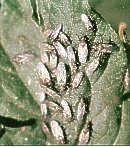
Impact
These pests occur mainly in early blocks when its cool and can damage leaves and cause quality problems if they are harvested with the lettuce.
Description and Symptoms
False chichbugs are small 1/4 inch or 6 - 7 mm long brown beetles with small eyes. They resemble big-eyed bugs except for the small eyes.
Integrated Management
These pests occur during cool temperatures and can multiply very rapidly. Their feeding on leaves can leave small cavities and white discolorations on leaves. Large populations can result in bugs being harvested with lettuce which can lead to food quality problems and rejected loads. They are hard to control, but endosulfan and malathion can be used. Control them before populations get too high. Threshold for control is 1 false chinchbug per plant. Its important to kill the chinchbugs at least 1 week before harvest to allow the dead bugs in the heads to decay so they are unrecognizable to consumers. Remember a dead bug in produce is just as bad as a live bug.
Aphids
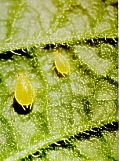
Impact
Aphids often feed on lettuce crops. They can damage a lettuce crop by vectoring diseases, physical damage from too much feeding and quality problems if aphids are harvested with the lettuce. They usually are not a problem in the San Luis Valley of Colorado.
Description and Symptoms
Aphids are soft bodied insects that occur in winged and wingless forms. There are various types of aphids that colonize lettuce as well as many other adult forms that just move though a lettuce crop. The main aphids forund on lettuce are: Green peach aphid, potato aphid, turnip aphid and cabbage aphid. Aphids are sucking insects that mainly feed on the lower and underside of leaves. Aphid population growth is related to degree day growth and thresholds can be set.
Integrated Management
Aphids can vector viruses which is not a big problems if virus free or indexed seed is used. If aphid levels reach 30 to 50 per plant control measures may be needed. Natural predators are very effective against aphids. Young plants can withstand much less aphids than mature plants. Aphids are usually on only lower leaves of lettuce that are not harvested so low aphid levels are usually not a problem. Insecticides are rarely needed.
Other Insect Pests
Lettuce Root Aphid (Pemphigus bursarius)
T%his is an occasional pest of lettuce. The aphids occur on the roots in clusters colonies covered with a white powdery wax. The root aphids damage the lettuce roots and outer leaves may wilt. Yield reductions and soft heads may result with high populations. The lettuce root aphid overwinters on Lombardy poplars. Aphids are usually not found within 2 miles of lombardy poplar trees. Avoid planting lettuce near lombardy poplars. Some resistent varieties exist. The only ssytemic insecticide available must be applied at planting.
Leaf Miners (Liriomyza sp.)
Leafminer damage si done by the larval stage of a small sender yellow brown fly with a yellow spot between its wings. The fly maggots are small, yellow and legless and feed between the upper and lower leaf surfaces creating tunnels in the leaves. In lettuce the leaf miner usually only feeds on the lowest leaves that are not harvested and causes minimal damage. Control is not needed. Parasitic wasps are important natural enemies.
Cutworms (Agrotis sp., Peridroma sp.)
Cutworms are brown worms that form a "C" when disturbed. Cutworms cause occasional damage to lettuce seedlings. Monitoring a newly emerged field you will find stumps in a row of young lettuce stems. Monitor fields just after overhead irrigation of a rain when the worms will be on the soil surface and easy to find. Problems most often occur after an alfalfa or grain rotation.
Flea Beetles (Epitrix cucmeris, Phyllotreta sp.)
Flea beetles are very small shiny black beetles that can jump very far when disturbed. They eat small holes in leaves as they feed. They are occasional lettuce pests early season when plants are small. Flea beetles often prefer many weeds to lettuce (especially mustards) so before the first weeding when the lettuce is most susceptible the flea beetle will leave the lettuce alone. Control flea beetles after thinning if beetle damage affects more than 20 % of leaf surface.
Flies and Miscellaneous Insects (or fliers as the harvest crews call them)
There are lots of insects that inhabit lettuce fields. Many of them are not damaging to the crop, but if they end up in the heads going to market, the load could be rejected and end consumers may complain. It is sometimes necessary to kill of these non-harmful insects to just keep them out of the heads. If this is necessary, do it around 1 week prior to harvest to the dead bugs in the heads have time to decompose.
Note: This information should only be used as a guide. Adjustments for local conditions must always be made.